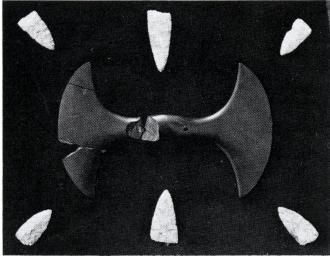Pendants and Gorgets

By Bill Koup, Albuquerque, New Mexico
Personal adornment has always been an important pursuit of mankind. The wearing of specialized adornments for the purpose of appearing more attractive or to signify an individual’s rank, wealth or status has been documented with great regularity throughout the entire scope of mans’ history. Even the scarification and tattooing of skin has frequently signified great wealth or high status with particular societies. The use of various forms of jewelry and other decorative embellishments to the body or clothing has long been and probably always will be a popular and significant form of personal expression for nearly all humankind.
The prehistoric peoples of North America were in no way different to other societies in this regard. Literally thousands of artifacts including pendants and gorgets have been recovered that have no apparent use other than to enhance the owner’s personal presence. Some of these artifacts are most certainly akin to jewelry. Many of these items were worn to please the owner and to perhaps impress others of their personal wealth or sexual attractiveness. Certainly, there were many other types of adornments other than pendants and gorgets made and worn for the express purpose of signifying status within their respective societies. Perhaps a good anology would be the various patches and insignias worn by military personnel to designate rank, service and prestige. Another anology would be pins, watches, money clips and other items that have been awarded to individuals for their distinguished service at their place of employment. Even designer clothing with specific logos may be considered late 20th century manifestations of the desire for people to adorn themselves in ways to exhibit wealth or status.
So, are pendants and gorgets merely items of personal adornment worn to impress others or to signify status or wealth? Although no one at this time can be absolutely certain of the specific meaning of pendants and gorgets, chances are pretty good that is exactly what they are. Unlike many other artifact types whose specific purpose and use is highly speculative, pendants and gorgets appear to have been used as items of status, societal affiliation and certainly for personal adornment. Indeed, there is a significant body of documented archaeological evidence illustrating the fact that pendants and gorgets were worn as items to be proudly displayed on the body or clothing of the owner.
Pendants and to a lesser degree gorgets, have been discovered in nearly all areas of North America and among nearly all prehistoric cultures. They have been located in controlled archaeological excavations and on the surface as isolated field finds. Although most areas of North America had at one time supported pendant and gorget producing people, the Midwest and South seem to be centers for the production of these interesting forms.
Indeed, the Glacial Kame, Adena, Hopewell, Ft. Ancient and Mississippian cultures from Ontario,Canada, throughout the Great Lakes areas down the Ohio and Mississippi River valleys all produced various distinctive pendant and gorget forms. So distinctive and stylistically similar are many of these forms that it has become relatively easy to identify them as having been produced by a specific culture. It is even possible to identify some types of gorgets and pendants as being either early, middle or late in the scope of a particular society’s existence.
